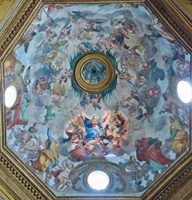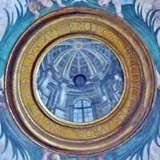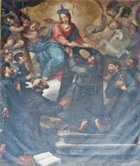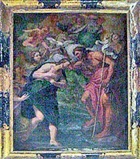Giuseppe Nicola Nasini
Giuseppe Nicola Nasini was born in Castel del Piano, near Siena, and belonged to a family of artists. He trained in Rome in 1681-8 and then became the court artist of the Grand Duke Cosimo III of Florence. He returned to Rome in 1718-23, before moving to Siena, where he died.
Foligno
Assumption of the Virgin (1716)


The inscription around the base of the lantern above the crossing of San Giacomo records that Prior Luca Pucci commissioned its decoration in 1716. The illusionistic depiction of the windows in the lantern and the surrounding fresco of the Assumption of the Virgin are attributed to Giuseppe Nicola Nasini. The depiction of the interior of the fictive lantern was based on the trompe-l’oeil lantern(1685) by Andrea Pozzo in Sant’ Ignazio di Loyola, Rome.
Panels in Sant’ Apollinare (early 18th century)
Two panels were documented in Sant’ Apollinare in 1728, with an attribution to Giuseppe Nicola Nasini:
-
✴the Deposition; and
-
✴the Resurrection of Christ.
They [remain in the church?] and are illustrated in black and white in the website of the Fondazione Federico Zeri.
St Leonard (early 18th century)
This panel in San Leonardo (Santa Maria del Pianto) by Giuseppe Nicola Nasini was destroyed, like the church itself, in the bombardment of the Second World War.
Gubbio
Works in San Pietro (18th century)
Four panels in San Pietro were documented in 1786 with an attribution to Giuseppe Nicola Nasini, two in each of the transepts. Another document from the mid 19th century added to this list an altarpiece of the Blessed Bernard Tolomei (the founder of the Olivetan Congregation, to whom the chapel in the right transept was dedicated).
-
✴The two panels in the Cappella del Crocifisso (in the left transept) survive in situ. They depict:
-
•the Deposition; and
-
•the road to Calvary.
-
✴The three works in the Cappella del Beato Bernardo Tolomei were removed in 1831 when the church passed to the Camaldolesians:
-
•the altarpiece of the Madonna and Child enthroned with Blessed Bernard Tolomei is now on the 2nd altar on the right, but
-
•the two side panels, which probably depicted scenes from the life of the Blessed Bernard Tolomei, no longer survive.
Tommaso Nasini
Tommaso Nasini, who was probably a cousin of Giuseppe Nicola Nasini, probably spent his entire career at Foligno. He was first documented there in 1707, when he painted the face of a public clock. His frescoes (1723) in the cupola of San Michele, Sterpete (near Foligno) were documented in 1727. He illustrated a book (ca. 1740) by Francesco Nuti that described the arms of the noble families of Foligno.
Works in San Leonardo
Three documented works by Tommaso Nasini in San Leonardo (Santa Maria del Pianto) were destroyed, like the church itself, in the bombardment of the Second World War:
-
✴two angels (1725); and
-
✴oval panels (1740), depicting:
-
•the Birth of the Virgin; and
-
•the Assumption of the Virgin.
Annunciation of the Passion (1744)
This altarpiece, which is signed by Tommaso Nasini and dated by inscription, is [on which altar?] of the church of the Abbazia di Sassovivo. It depicts the Madonna and Child and an angel who points to putti above, one of whom holds a cross.
Works in San Giacomo (18th century)
-
✴the frescoes (1707) in the apse, which are dated by inscription and include the arms of Prior Luca Pucci; and
-
✴the altarpiece of the Virgin with the founders of the Servite Order, on the 2nd altar on the left (illustrated here).
Baptism of Christ (18th century)
SS John of Capestrano and Paschal Baylon (18th century)
This panel in San Bartolomeo di Marano (on the altar on the right) is attributed to Tommaso Nasini. It depicts two Franciscan saints:
-
✴St John of Capestrano, who had been canonised in 1724; and
-
✴St Paschal Baylon, who had been canonised in 1690.





